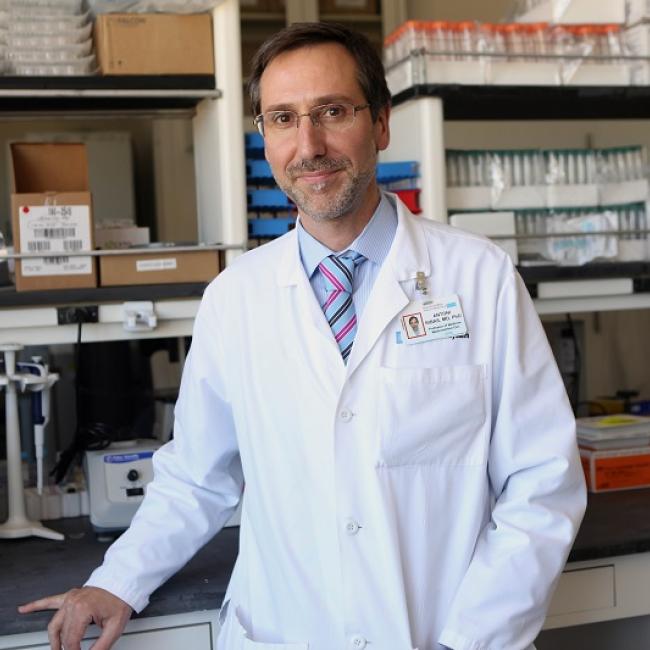
UCLA physician-scientist receives $5 million grant to move wound healing gel to clinical trial
UCLA physician-scientist Dr. Antoni Ribas has received a grant of more than $5 million from the California Institute for Regenerative Medicine, the state’s stem cell agency, to further the development of a novel gel that could help heal chronic wounds.
The grant, which was awarded Thursday, will support Ribas’ efforts to complete the testing and manufacturing necessary to apply to the Food and Drug Administration for permission to start a clinical trial in patients.
If the objectives of the grant are met, Ribas hopes to launch a trial evaluating the topical gel as a treatment for venous leg ulcers, which are sores on the legs that heal very slowly due to restricted blood flow. Venous leg ulcers affect 1 to 3% of Americans and can last anywhere from a few weeks to years.
“This condition has a disproportionate effect on underserved populations and is common among people with diabetes, obesity and limited movement,” said Ribas, a member of the Eli and Edythe Broad Center of Regenerative Medicine and Stem Cell Research at UCLA and director of the Tumor Immunology Program at UCLA’s Jonsson Comprehensive Cancer Center. “Venous leg ulcers can cause chronic pain, loss of function and mobility, social isolation and lead to increased time spent in hospitals. They can take a severe toll on patients’ quality of life and there are no currently approved drugs to treat them.”
Ribas’ potential therapy for this condition is a gel called LUT017. In studies in mice models of skin wounds, the compound was found to stimulate skin stem cells to produce all kinds of skin cells and regenerate damaged tissue, thus accelerating wound healing.
A world leader in the development of immunotherapies for cancer, Ribas didn’t set out to develop a topical gel treatment for persistent wounds that heal slowly. Rather, the genesis of this treatment came from a surprising side effect he observed among patients with melanoma who were being treated in a clinical trial of a therapy he helped develop called vemurafenib, marketed as Zelboraf.
This treatment falls into a category of targeted cancer drugs called BRAF inhibitors, which can shrink or slow the growth of metastatic melanoma in people whose tumors have a mutation to the BRAF gene.
“We noticed that in the first two months of taking this BRAF inhibitor, patients would begin showing a thickening or overgrowth of the skin,” said Ribas, who is also professor of medicine in the David Geffen School of Medicine at UCLA. “It was somewhat of a paradox – the drug stopped the growth of skin cancer cells with the BRAF mutation, but it stimulated the growth of healthy skin cells.”
After developing a strategy to overcome this side effect in patients with melanoma, Ribas realized that the drug’s skin stimulating effect could be put to good use for a whole other group of patients – those with chronic wounds.
“Aside from a few famous cases, discovering a side effect that becomes a therapeutic isn’t that common,” Ribas said. “For this reason, I had to work hard to convince somebody in my lab to follow my crazy idea and take time away from immunotherapy research to do wound healing experiments.”
For help with these experiments, the Ribas lab tapped into the expertise of colleagues who study wound healing and bioengineering, UCLA professors William McBride, Roger Lo, Phillip Scumpia and Tatiana Segura, who is now at Duke University.
“We used their mouse models of wound healing to test our hypothesis, and found that our drug worked in every one of the animals we tested,” said Ribas. “On average, the wounds of mice treated with the drug healed between 40 and 50% faster than the wounds of mice that did not receive the treatment.”
Because the safety of BRAF inhibitors has been studied in humans for over 10 years, Ribas is optimistic that there will be a clear path for the therapeutic gel candidate to reach the clinic. And if a clinical trial of the gel as a treatment for venous leg ulcers goes well, he hopes the gel could be tested for use in healing other types of chronic wounds, regardless of their origins.
The compound described in this article has only been used in preclinical tests and has not been tested in humans or approved by the Food and Drug Administration as safe and effective for use in humans for wound healing.
